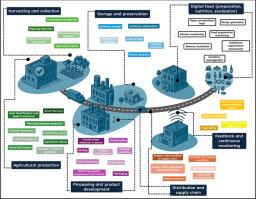Exploring the potential of digital twins in the food industry and their role in developing food formulations
IF 3.9
3区 工程技术
Q3 ENERGY & FUELS
Chemical Engineering and Processing - Process Intensification
Pub Date : 2025-10-09
DOI:10.1016/j.cep.2025.110583
引用次数: 0
Abstract
Digital twins have been used across various industries to reduce workload and costs while enhancing process efficiency, aligning with the goals of process intensification. Their application in the food industry is limited, particularly in the industrial-scale food product formulation. This review provides a comprehensive analysis of the current status, benefits, limitations, and prospects of DT applications in the food industry. Authors perform an extensive literature review for the last 20 years using different databases like Scopus, Pubmed, ResearchGate, and academic editorials. Food formulation using DTs allows for the development of personalized recipes tailored to specific nutritional profiles, sensory properties, and target groups. They also facilitate the optimization of food formulas to improve food security, shelf-life, and ingredient composition. Sensory evaluation can be enhanced using virtual environments, biometric sensors, and AI-generated food images. Challenges in DT implementation in the food industry include high digitalization requirements, data accessibility and ownership issues. The integration of DTs with AI, IoT, and big data analytics further enhances their capabilities in predictive maintenance, quality control, and supply chain optimization. Despite these challenges, the potential benefits of DTs in food formulation are considerable, demanding a multidisciplinary approach to effectively and swiftly address consumer demand and industry issues.

探索数字孪生体在食品工业中的潜力及其在食品配方开发中的作用
数字孪生已在各个行业中使用,以减少工作量和成本,同时提高流程效率,与流程强化的目标保持一致。它们在食品工业中的应用是有限的,特别是在工业规模的食品配方中。本文综述了DT在食品工业中的应用现状、优点、局限性和前景。作者使用不同的数据库,如Scopus、Pubmed、ResearchGate和学术社论,对过去20年的文献进行了广泛的回顾。使用DTs的食品配方允许开发针对特定营养概况,感官特性和目标群体的个性化配方。它们还有助于优化食品配方,以提高食品安全、保质期和成分组成。感官评估可以通过虚拟环境、生物识别传感器和人工智能生成的食物图像来增强。在食品行业实施数据挖掘的挑战包括高数字化要求、数据可访问性和所有权问题。dt与人工智能、物联网和大数据分析的集成进一步增强了他们在预测性维护、质量控制和供应链优化方面的能力。尽管存在这些挑战,食品配方中直接转化物的潜在好处是相当大的,需要一种多学科的方法来有效和迅速地解决消费者需求和行业问题。
本文章由计算机程序翻译,如有差异,请以英文原文为准。
求助全文
约1分钟内获得全文
求助全文
来源期刊
CiteScore
7.80
自引率
9.30%
发文量
408
审稿时长
49 days
期刊介绍:
Chemical Engineering and Processing: Process Intensification is intended for practicing researchers in industry and academia, working in the field of Process Engineering and related to the subject of Process Intensification.Articles published in the Journal demonstrate how novel discoveries, developments and theories in the field of Process Engineering and in particular Process Intensification may be used for analysis and design of innovative equipment and processing methods with substantially improved sustainability, efficiency and environmental performance.

 求助内容:
求助内容: 应助结果提醒方式:
应助结果提醒方式:


